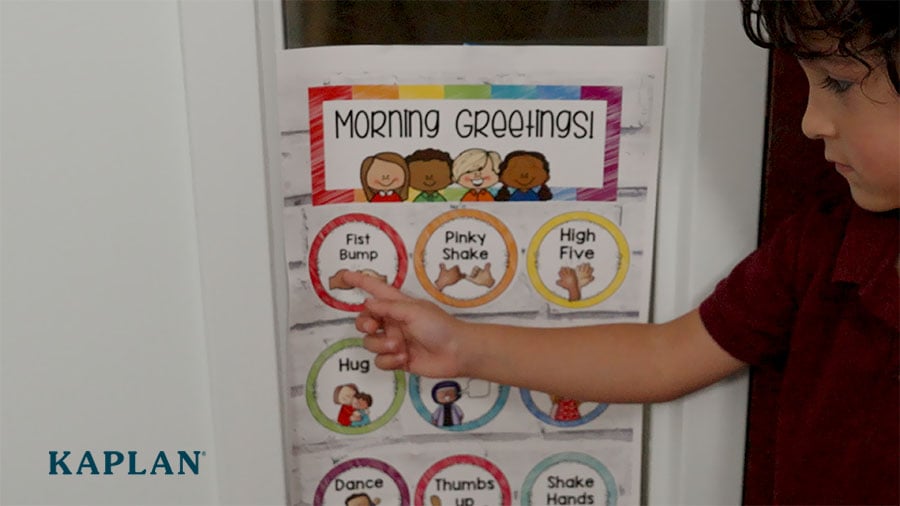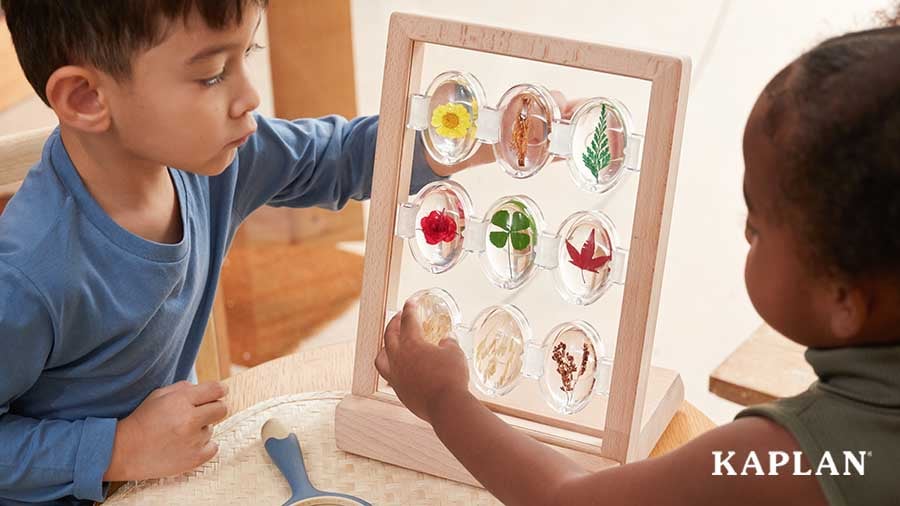Transitioning from a home environment to a school classroom can create a variety of emotional challenges for young children.
Some children will cry and cling to their parent's legs, terrified of being left alone. Some children will fall to the floor in a rage, blocking the door to the classroom in the hopes that it means they will not have to stay at school. Some children want to sit silently in a corner of the classroom, unwilling to engage in any activities or play.
As an early childhood teacher, you strive to make the transition from home to school as peaceful as possible for the children in your classroom. You want families to feel comfortable leaving their children in your care and children to feel that same level of comfort when their family members are not around. However, you understand how challenging it can be to assist children with their emotions effectively and meaningfully.
As a leader in early childhood education, Kaplan also understands these challenges. That is why we work closely with industry experts, designers, and manufacturers to create heart-centered classroom furnishings, materials, and resources that make children feel warm and welcome – like they are entering a home away from home. In this article, we share nine ways you can help children peacefully transition from home to school in your classroom.
Establish a Predictable Morning Routine
In order for children to feel safe and secure while at school, they need to experience the classroom as a trustworthy, predictable, and reliable space. Daily structure and routines will create this type of environment in your classroom. A peaceful and predictable morning routine can look like this:
Meet Children at the Door Each Morning
At the start of every day, stand at the door to greet children as they enter your classroom. This interaction deepens the child/teacher bond and helps children feel a sense of security in your presence. Your morning greeting can also set the tone for the day, helping to brighten moods and lift spirits.
Create a Child-Approved Greeting
Give children autonomy over their morning routine so they feel in control of their entrance into your classroom. One way to do this is by allowing each child to choose how you will greet them at the door. Some children like hugs. Others prefer to slip into the classroom with nothing more than a quick wave from their teacher. Create a “Greeting Chart” near your classroom door so children can choose a morning greeting that matches their mood. A few examples of greetings you can include on this chart are a hug, fist bump, high five, wave, elbow bump, etc.

Give Children a Secure Space to Place Their Belongings
Many children find comfort in personal items such as stuffed animals, blankets, letters from family members, etc. The only downside is that children must put their personal belongings away when entering an early childhood classroom. Cubbies and storage units give children a designated space to place their comfort items, a change of clothes, paperwork, and other personal belongings. Label your cubbies and storage units with each child’s name so they can easily find their cubby each morning and work on name recognition simultaneously.
Make the Transition from Home to School Engaging and Fun
Disruptive behaviors during the home-to-school transition typically arise when children feel like the change is abrupt and unexpected. Families can help alleviate these feelings by preparing their children for the beginning of the school day before they leave home in the morning. As an early childhood teacher, you can prepare children for this transition using pocket charts to display your daily schedule.
You can also use pocket charts and paper cutouts shaped like people to create an attendance board near your door. Children can move their “person” from the pocket labeled “home” into the pocket labeled “school.” Activities like this make the transition process fun and exciting for children.
Help Children Ease Into Classroom Fun
Typical early childhood classrooms are active, noisy places. This atmosphere can be overwhelming for some children and make them nervous about participating in open-ended play with their classmates. You can provide positive reassurances and help children learn to manage their emotions by encouraging them to:
Play Emotional Identification Games and Activities
To help children work through their emotions, you first need to understand what they are feeling throughout the day. Using pictures and drawings is a great way to help children identify their feelings and put a name to them.
One activity that can help with this process is a “How I Feel About…” game. To start, create a grid on paper that includes images of different things children will do during a typical school day. Some examples are going to school, playing with friends, going outside, eating lunch, or reading a book. Using emotion stamps and an ink pad, have children stamp a face beside each image that resembles how they feel about participating in that activity.
If children stamp a negative emotion, ask them why they feel that way and offer solutions to help them experience that activity more positively.
Use Captivating Materials to Explore Their Curiosities
Positioning toys and captivating materials near the entrance to your classroom can help children engage in playful fun before they have a chance to feel negative emotions about leaving home. For children who have difficulty transitioning into the classroom, encourage family members to sit and play with their child before leaving. This can give the child some time to feel comfortable in their new surroundings before their family member leaves. These captivating materials also open up the possibility for cooperative play away from the hustle and bustle of the main classroom.

Find Comfort in a Stuffed Animal or Toy
For some children, a stuffed animal or soft toy provides a sense of comfort and security when they are feeling nervous and scared. Squeezing soft toys can help children relieve stress and calm their anxieties. Incorporate cuddly dolls and animals in your dramatic play center and reading nook so children can find comfort whenever they need it most.
Read Books to Help With Emotional Problem-Solving
Children can start working through their emotions once they fully understand them. Reading stories featuring fun characters and relatable scenarios can help children learn to manage their own emotions in a socially acceptable way. Choosing books related to going back to school is a great way to help children work through the home-to-school transition period. You can loan these books to family members so they can provide additional support while the child is at home.
Write Down Their Worries and Send Them Away
Some children experience long-lasting negative emotions during their home-to-school transition. It may seem as though they will never experience happiness or joy when they enter your classroom. To help these children release their negative emotions, ask them to participate in a “worry send-off” game.
Ask the child to draw a picture of something they are worried about on a piece of paper. Then fold the paper and place it inside a basket, jar, or anything with a lid. Now, take the worry outside the classroom and toss it in the trash. This provides a visual for the child that their worries are gone, and they can begin focusing on the positive experiences they will have in your classroom.
How Will You Help Children With the Home to School Transition in Your Classroom?
As you know, children face many emotions and challenges when transitioning from home to school. Using the ideas from this article, you now know how to create peaceful transition experiences that will help children feel comfortable stepping into your classroom. If you are wondering how these techniques will work for you in your classroom, we’ve created a video that will show you each of these nine techniques in use in an early childhood classroom and how a young child responds to them.

